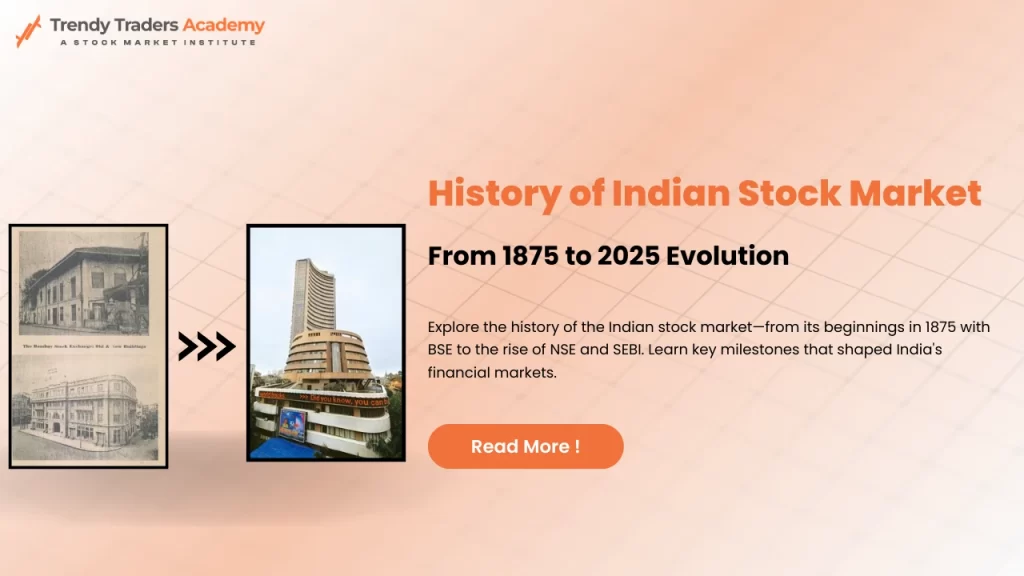The Fascinating History of Indian Stock Market: From Dusty Bazaars to Digital Trades
Have you ever wondered how India’s vibrant stock market came into being? From chaotic, handwritten deals on the streets of Bombay to digital platforms executing trades in milliseconds, the history of Indian stock market is nothing short of a roller-coaster. If you’re considering diving into trading or taking up one of the many trading courses out there, understanding this history could give you a real edge.
In this article, we’ll take a deep dive into how the Indian stock market evolved, key milestones along the way, and how modern education—like the best trading courses—can prepare you to navigate this ever-changing world.
Explore the rich history of Indian stock market, discover trading courses, and learn how to choose the best trading courses for success.
Introduction to the Indian Stock Market
The Indian stock market isn’t just about numbers and graphs—it’s a living, breathing system reflecting the pulse of the economy. Just like any epic journey, it had humble beginnings, hit a few bumps along the way, and is now growing faster than ever. Whether you’re an investor or just curious, knowing where it all started gives you a solid foundation.
The Humble Beginnings in the 1800s
Think of a time before computers, electricity, or even proper offices. In the 1850s, a group of 22 stockbrokers would gather under a banyan tree in front of Mumbai’s Town Hall. That’s right—trading in India literally began under a tree!
These men were trading cotton shares, influenced heavily by British economic interests. This was the seed that would grow into a billion-dollar industry.
The Birth of BSE – Asia’s First Stock Exchange
By 1875, the informal gatherings had become more structured. That’s when the Bombay Stock Exchange (BSE) was officially established. Fun fact: BSE is Asia’s oldest stock exchange, predating many European markets.
BSE initially dealt with cotton, then expanded to stocks and securities. This marked the beginning of organized trading in India.
Pre-Independence Trading Scene
Before 1947, the Indian stock market was dominated by British companies. Indian participation was limited, though it began to rise slowly in the 1930s and 40s.
While many indigenous businesses started to list, the overall market lacked transparency and structure—leading to frequent scams and investor distrust.
Post-Independence Transformation
After independence, India needed economic self-reliance. The stock market played a small, supporting role initially, but reforms started creeping in during the 1950s and 60s.
The 1970s brought more regulation and government intervention, but markets remained largely out of reach for the common man. Everything was still manual, making it slow and inaccessible.
The Era of Reforms – 1991 and Beyond
India’s 1991 economic liberalization was a game-changer. With the economy opening up to global markets, the stock market witnessed a surge in activity.
Foreign Institutional Investors (FIIs) were allowed to invest, new companies rushed to go public, and the need for a more efficient system became obvious.
Rise of NSE and Electronic Trading
To counter the limitations of BSE’s open outcry system, the National Stock Exchange (NSE) was born in 1992. It revolutionized the market by introducing fully automated electronic trading.
With NSE, investors across the country could now trade easily, transparently, and fairly. This also marked the beginning of dematerialized (demat) shares and online trading.
Major Scandals That Shaped Regulations
From the Harshad Mehta scam in 1992 to the Ketan Parekh scandal in 2001, the Indian stock market has seen its share of dark days. But each scandal pushed the system to become better and more regulated.
These events were painful but necessary for growth—like bitter medicine. They triggered reforms that made the market more robust and trustworthy.
SEBI: The Watchdog That Changed It All
The Securities and Exchange Board of India (SEBI) was established in 1992 to bring order to the chaos. Since then, SEBI has become the market’s watchdog—regulating brokers, investors, mutual funds, and companies.
Today, thanks to SEBI, India has one of the most well-regulated markets in the world, attracting investors globally.
The Digital Boom and Rise of Retail Investors
The 2000s saw a boom in internet access and smartphones. Combined with platforms like Zerodha and Upstox, this opened the market to retail investors—people like you and me.
Earlier, investing felt like rocket science. Now, with a few taps on your phone, you can buy a piece of India’s biggest companies.
Understanding Modern-Day Trading in India
Today’s stock market is fast, digital, and complex. Apart from shares, you can now trade in derivatives, commodities, and even cryptocurrencies (though with caution).
Algorithmic trading, AI-based predictions, and mobile apps have made it exciting—but also riskier. That’s where knowledge becomes power.
Why Learning Matters: Trading Courses Explained
Let’s face it—trading can be overwhelming. That’s why trading courses are so important. These aren’t just for finance students; anyone interested in wealth-building can benefit.
From understanding candlestick charts to risk management, courses help turn guesswork into strategy.
How to Choose the Best Trading Courses
With so many options out there, how do you know which ones are worth your time—and money? Choosing the best trading courses can be the game-changer in your trading journey.
Here are a few key things to look for:
- Accreditation – Is it from a recognized institute or expert?
- Content Depth – Does it cover both basic and advanced strategies?
- Real-World Application – Are you learning just theory, or is there hands-on trading involved?
- Mentorship and Support – Can you reach out to experts for help?
- Community Access – A good peer network can be incredibly helpful.
Trendy Traders Academy: A Standout Choice
One institute that’s getting a lot of attention these days is Trendy Traders Academy. Known for its practical, real-world trading approach, this academy offers a range of programs for beginners to advanced traders.
Here’s why it’s worth checking out:
- Expert-Led Training: Courses are designed and taught by seasoned traders.
- Live Market Sessions: Learn how to trade in real-time with market guidance.
- Mentorship & Support: Direct access to mentors ensures personalized learning.
- Community Vibes: You’re never alone; join a network of like-minded learners.
If you’re serious about trading and want to avoid common beginner pitfalls, Trendy Traders Academy could be the stepping stone to your financial goals.
Stock Market Today: Where We Stand
Today, India’s stock market is among the top five globally in terms of market capitalization. It’s a space where unicorn startups go public, and even retail investors play major roles in IPO success.
The focus now is on inclusion, technology, and sustainability.
Conclusion: The Road Ahead
The history of Indian stock market teaches us that change is the only constant. From banyan trees to blockchain, it’s come a long way—and so can you.
Whether you’re a curious observer or a future trader, knowing this history empowers you to make smarter choices. And with the right trading courses, you could be the next success story in this ever-evolving market.






